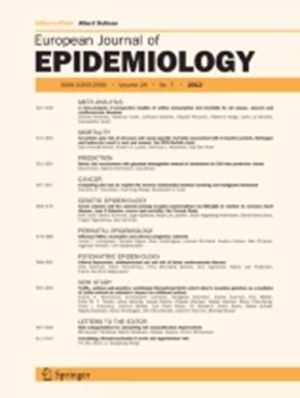体质指数与长期病假风险的工具变量分析:HUNT研究,挪威。
IF 5.9
1区 医学
Q1 PUBLIC, ENVIRONMENTAL & OCCUPATIONAL HEALTH
引用次数: 0
摘要
需要更全面地了解身体质量指数(BMI)与病假之间的因果关系。我们的目的是使用工具变量方法检查BMI对特定原因和全原因长期病假风险的影响。该研究包括21918名成年人,他们参加了基于人群的HUNT研究(HUNT3, 2006-2008年和HUNT4, 2017-2019年)的两项最新调查,这些调查与特定原因病假的登记数据有关,包括肌肉骨骼和精神疾病。我们采用常规的BMI分析和基于子代BMI的工具变量分析,采用Cox回归来估计长期病假对BMI z得分每标准差(SD)增加的风险。在常规分析中,BMI z得分每SD增加的风险比范围从女性精神健康障碍的1.04(95%可信区间(CI) 0.99-1.08)到男性肌肉骨骼疾病的1.17 (95% CI 1.13-1.22)。工具变量方法支持较高的BMI增加了长期病假的风险,但男性因精神健康障碍而请病假的情况除外。分析表明,后代BMI作为一种工具并不是独立于共同的混杂因素。常规变量分析和工具变量分析的结果表明,高BMI会增加长期病假的风险,但男性因精神健康障碍而请病假的情况除外。工具变量法有可能消除反向因果关系造成的偏倚,但不能排除共同混杂因素造成的残留偏倚。本文章由计算机程序翻译,如有差异,请以英文原文为准。
An instrumental variable analysis of body mass index and risk of long-term sick leave: the HUNT Study, Norway.
A more comprehensive understanding of the causal relationships between body mass index (BMI) and sick leave is needed. We aimed to examine the effect of BMI on the risk of cause-specific and all-cause long-term sick leave using an instrumental variable approach. The study included 21,918 adults participating in the two latest surveys of the population-based HUNT Study (HUNT3, 2006-2008 and HUNT4, 2017-2019) linked with registry data on cause-specific sick leave, including musculoskeletal and mental disorders. We used Cox regression to estimate risk of long-term sick leave per standard deviation (SD) increase in z-score of BMI, applying both conventional analysis of own BMI and instrumental variable analysis based on offspring BMI. In the conventional analyses, hazard ratios per SD increase in z-score of BMI ranged from 1.04 (95% confidence interval (CI) 0.99-1.08) for mental health disorders in women to 1.17 (95% CI 1.13-1.22) for musculoskeletal disorders in men. The instrumental variable approach supported that higher BMI increased the risk of long-term sick leave, except for sick leave due to mental health disorders in men. The analyses suggested that offspring BMI as an instrument is not independent of shared confounding. The results from both the conventional and instrumental variable analyses show that higher BMI increases the risk of long-term sick leave, except for sick leave due to mental health disorders in men. The instrumental variable method is likely to remove bias due to reverse causation, but residual bias due to shared confounding factors cannot be ruled out.
求助全文
通过发布文献求助,成功后即可免费获取论文全文。
去求助
来源期刊

European Journal of Epidemiology
医学-公共卫生、环境卫生与职业卫生
CiteScore
21.40
自引率
1.50%
发文量
109
审稿时长
6-12 weeks
期刊介绍:
The European Journal of Epidemiology, established in 1985, is a peer-reviewed publication that provides a platform for discussions on epidemiology in its broadest sense. It covers various aspects of epidemiologic research and statistical methods. The journal facilitates communication between researchers, educators, and practitioners in epidemiology, including those in clinical and community medicine. Contributions from diverse fields such as public health, preventive medicine, clinical medicine, health economics, and computational biology and data science, in relation to health and disease, are encouraged. While accepting submissions from all over the world, the journal particularly emphasizes European topics relevant to epidemiology. The published articles consist of empirical research findings, developments in methodology, and opinion pieces.
 求助内容:
求助内容: 应助结果提醒方式:
应助结果提醒方式:


